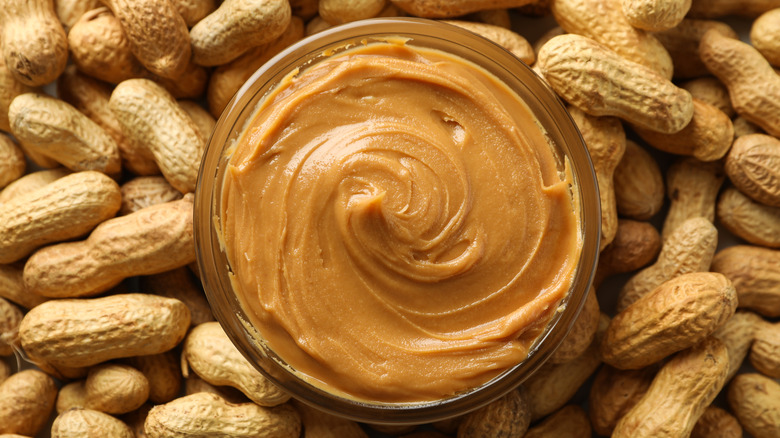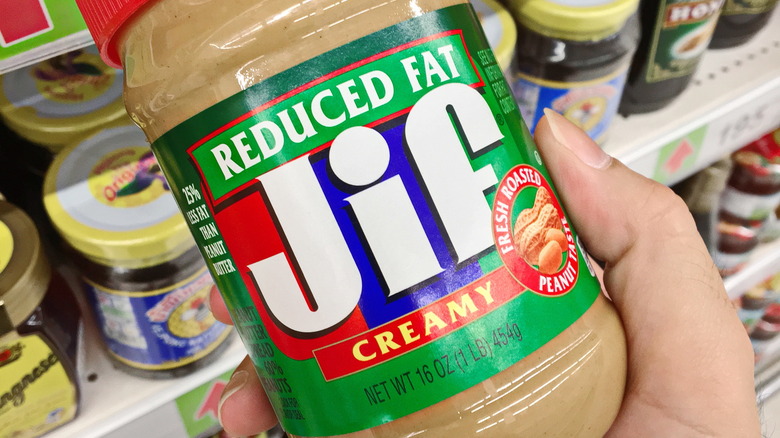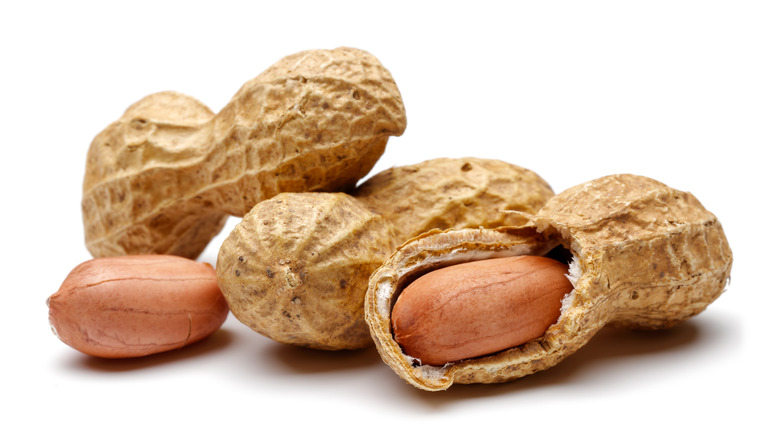Why Reduced Fat Peanut Butter Is A Hoax
If someone ever starts a sandwich hall of fame (and someone definitely should), there's no question who the first inductee would be. Peanut butter and jelly, known to fans as PB&J, is the undisputed lunch box champion. This deceptively simple union of only three ingredients, the sweet and salty taste of youth, holds an important place in countless hearts. And yet, over the past three decades or so, some have questioned whether PB&J is a healthy choice for their, or their children's, diets. The principal point of worry is the high-fat content of peanut butter. 100 grams of raw peanuts contains 49.2 grams of fat, nearly half the overall mass.
In the second half of the 20th century, a series of scientific studies were conducted that linked high-fat diets to high-cholesterol levels, and consequently, higher rates of heart disease and obesity (via the Journal of the History of Medicine and Allied Sciences). By 1980, Americans came to view fat as the most dangerous thing in food, and by the 90s, fat-free and reduced fat products were selling like gangbusters. Reduced fat peanut butter is a prime example. However, 21st-century research indicates that the anti-fat ideology was misleading. People failed to differentiate between unsaturated, saturated, and trans fats. Meanwhile, America's obesity epidemic got worse. It turns out that a lot of those reduced fat foods may have posed more nutritional concerns than the regular versions. Reduced fat peanut butter is the perfect case study in this trend.
The problem with reduced fat peanut butter
When Americans cut fatty foods from their diet at the end of the 20th century, they began eating more carbohydrates, including sugars. At the time, people actually believed this was healthier. Many of the low-fat foods people fell in love with were simply replacing that fat with more sugar, and reduced fat peanut butter is a prime example. To illustrate this, let's look at the two most beloved peanut butter brands in America: Skippy and Jif.
Skippy's natural peanut butter contains four ingredients: peanuts, sugar, palm oil, and salt. Yes, there is sugar there, but compare it to Skippy's reduced fat peanut butter, which includes corn syrup solids in addition to sugar. Both varieties have the same number of calories per serving: 190, but the regular version contains 4 more grams of fat. The reduced fat variety contains more than twice as many carbohydrates: 14 grams compared to just 6 in natural peanut butter.
Jif is similar. Their regular creamy peanut butter has 16 grams of fat compared to 12 grams in the reduced fat version. But once again, it trades that fat for more carbs. Regular Jif contains 8 grams of carbohydrates while the reduced fat kind contains 15. And while both varieties contain sugar, only the reduced fat kind contains corn syrup solids. Moreover, some of the fat that gets removed might actually offer health benefits.
Peanuts contain mostly good fats
Not all fats are created equal. There are monounsaturated, polyunsaturated, saturated, and trans fats. Both saturated and trans fats can raise your LDL cholesterol levels, which can create blockages in your arteries. Unsaturated fats, on the other hand, tip the balance towards HDL cholesterol ("good cholesterol"), which actually helps your body flush out the bad kind. Harvard Health strongly recommends reducing your saturated fat consumption. But instead of replacing it with refined carbohydrates as many Americans have done for decades, the organization suggests replacing it with unsaturated fat or high-fiber carbs. Fortunately, eating peanuts and peanut butter can be a fantastic way to do just that.
The fat in natural peanut butter is about 80% unsaturated, which is comparable to the fat in olive oil. There is some saturated fat in peanuts, but it's important to understand that all foods contain a mix of saturated and unsaturated fats, so you're looking for balance rather than the total elimination of one. Many foods that are widely considered healthy, including olive oil and tofu, contain a small amount of saturated fat. The bigger concern with any type of peanut butter is added sugar. Look for brands that only use peanuts and salt in their butter, or try making your own peanut butter at home. It's easier than you'd think.


